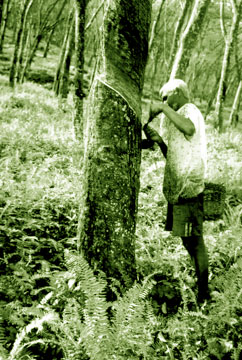What should be the next move in rubber plantations?
Continued from last week
by Dr. Lakshman RODRIGO
Reduction in overall bark consumption is the second advantage
providing several benefits. Obviously, this could be a practical
solution to higher rate of bark consumption that prevails in most of
plantations due to unskilled harvesters. The productive period of rubber
fields could be extended keeping the rubber tree for long. In a
particular estate, this increases the proportion of mature extent
providing more revenue.
 |
|
Dr. Lakshman Rodrigo |
Also, the application of LIH on virgin bark allows more time for bark
regeneration resulting in higher yields in renewed bark harvesting. The
delay in replanting brings numerous environmental benefits such as
reduced soil erosion, more organic matter to soil with continuous leaf
fall and additional CO2 sequestered combating the greenhouse effect.
Another benefit of LIH is the improved wages for harvesters. With the
use of yield stimulants, latex yield per harvest increases in low
frequency harvesting resulting in enhanced daily intake per harvester.
Even in the reduction of tapping cut length, higher intake per harvester
can be obtained with the increase in the tapping block/task size.
In RPCs, latex harvesters are paid an incentive for additional latex
harvested above the norm. Therefore with increased daily intake in LIH,
there will be a substantial increase in the income of latex harvesters.
Whilst minimising the usage of unskilled latex harvesters, such improved
wage structure will undoubtedly help to retain good harvesters in this
profession or motivate unskilled workers to become skilled. In the
rubber industry, this is another serious issue that can be addressed by
LIH.
Monetory value
Monetory value of any incentive paid to the worker is always less
than the value of additional latex brought in and of course, less than
the proportional payment to latex under the norm. Obviously, there is a
cost for the stimulants and its application. All such added costs are
less than the value of labour saving in LIH. Therefore, there is always
a reduction in COP hence greater profit margin could be experienced from
the application of LIH.
After intensive research, the Rubber Research Institute of Sri Lanka
(RRISL) has recommended two LIH systems for base panel tapping. These
systems are suitable for any clone recommended to tap with the
traditional S/2 d2 system and also for any stage of harvesting. With no
reduction in tapping cut length, harvesting systems having two tapping
frequencies are recommended, i.e. either tapping once in three (S/2 d/3)
or four (S/2 d/4) days on the base panels.
In the S/2 d/3, 2.5 percent of ethephon is applied 4-5 times per year
whilst 3.3 percent ethephon is to be applied monthly in the S/2 d/4
tapping. Commercial scale trials show that overall yields given by these
systems [in terms of average yield produced within a year by a tree
(YPT) or on hectare basis (YPH)] are comparable to that given by the
traditional S/2 d2 system. Increased profitability, reduction in COP,
increased earning of latex harvesters (up to about 20% in each case) and
reduced bark usage (up to about 45 percent) are also evident.
This article serves only as an eye-opener to the LIH systems and
anyone interested, could obtain the full application protocols from
RRISL.
The above recommended systems, there is a potential to tap the base
panels of the rubber trees with a quarter spiral cut once in three days
(S/4 d3). Ethephon has to be applied twice a month with 2.5 percent
concentration. While assuring the requisite yield level, this system too
provides all other benefits of LIH.
In particular, bark usage is reduced by about 60 percent. Since
commercial scale trials are in progress with this system, innovative
estate managers are also invited to participate in it. RRISL is prepared
to provide the technical knowhow and guidance for monitoring.
RRISL is working towards weekly harvesting systems which allow rubber
smallholders with off-farm involvements to tap their rubber fields
during the weekends.
 Results are promising but still premature for large scale commercial
applications. In addition to the application of LIH on base panels, such
systems could be used for effective utilisation of high panels. Being
with the virgin bark, high panels can provide substantial yield for a
longer duration; however in most instances, its potential is not really
explored by the old tradition of slaughter/intensified tapping. Results are promising but still premature for large scale commercial
applications. In addition to the application of LIH on base panels, such
systems could be used for effective utilisation of high panels. Being
with the virgin bark, high panels can provide substantial yield for a
longer duration; however in most instances, its potential is not really
explored by the old tradition of slaughter/intensified tapping.
Therefore, after completion of base panel harvesting for about 18
years, instead of intensified tapping, RRISL has recommended Control
Upward Tapping (CUT) with a shorter cut and reduced frequency (i.e. once
in three days) for efficient utilisation of high virgin panels. In CUT,
two options are available - to wit- stimulation with either ethephon
(CUT-ET) or ethylene gas (CUT-EG). As mentioned before, the former is
quite easy and not costly.
With monthly application of 5 percent ethephon, quarter spiral cut is
made on high panels in CUT-ET (S/4 d3). Special jackets are to be fixed
on the bark in the CUT-EG for periodical injection of ethylene gas.
This requires only 1/8 of the circumference of the tree for tapping
once in three days (S/8 d3) and hence the CUT-EG leads further saving of
the bark. Also, yield response to stimulation is quite fast. Despite
these advantages, field application of the CUT-EG demands high level of
attention particularly for the repairs of leaking jackets and
calibration of the gas cylinder. There are few commercially available
CUT-EG systems in the country (e.g. RRIMFLOW, G-Flex).
Those systems are rather expensive; however at the present price of
latex, it is still appears to be cost effective.
Gassing frequency
Despite the different manufacturers' recommendations developed for
other countries, the gassing frequency of 30 days was found to be
suitable for Sri Lankan clones. Anyhow, a gassing frequency of 15 days
could be applied during the last two years in tapping (i.e. two years
before uprooting). In general, yields given by LIH systems are slightly
less in drier regions probably due to the limitation in soil moisture.
Rubber latex comprises about 50-70 percent water. On each tapping day, a
greater volume of latex is to be extracted in LIH and plants may have
some difficulty to cope up with this in drier areas.
In wet regions, application of rainguards is very useful to make LIH
successful.
When compared with the traditional harvesting systems, any loss of
tapping days in above mentioned LIH systems has a greater impact on the
overall yield. Other basic recommendations in latex harvesting such as
panel marking for proper control in bark consumption and tapping angle
and correct placement of tapping utensils, are essential for the
effective use of LIH. More importantly, only the correct dose of
stimulants must be used with the relevant harvesting system.
Way forward
Only a few companies were able to enjoy the benefits of LIH. Since
there is a threat on overuse of stimulants at field level, some
companies are reluctant to move towards low intensity systems.
Also, it appears that some do not have enough confidence to undertake
the adoption of new technologies. All above reflect the need of
publicity programs and also field level workshops on LIH. Any additional
cost for such programs is affordable at this stage with the current
price for rubber latex.
Therefore, this is the correct time to move in such a direction. To
begin with, LIH could be adopted only in a division of the estate as a
pilot project. Else, RPCs can set up trials on LIH by selecting few
innovative estate managers. Other rubber growing countries such as India
and Malaysia have made a move. Of course, what is required is endurance
to meet the challenge.
However, we cannot be crazy with stimulants. RRISL is always prepared
to provide for those in need.
The writer is the Head of the Department of Biochemistry and
Physiology, Rubber Research Institute of Sri Lanka.
|

